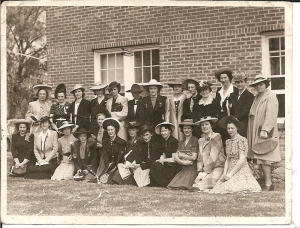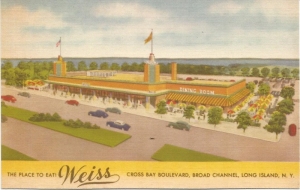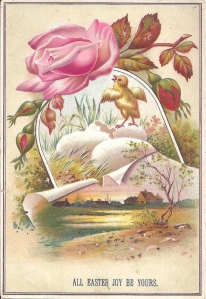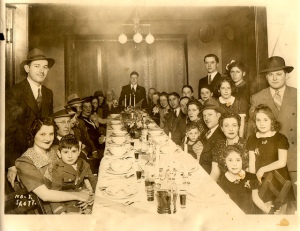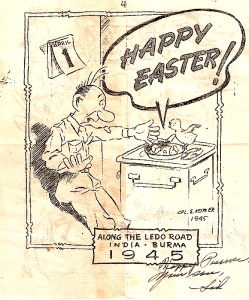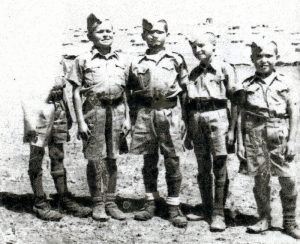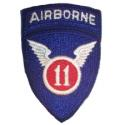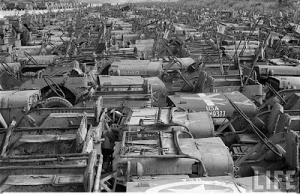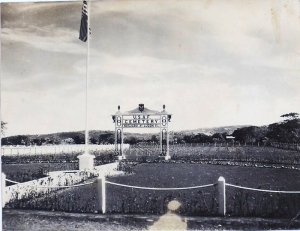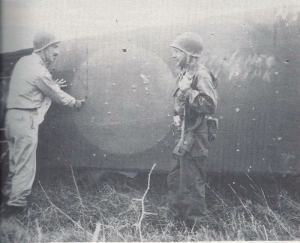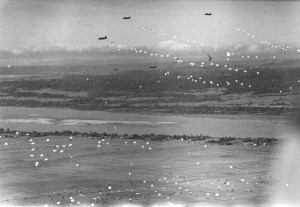Monthly Archives: March 2013
The ’40s – Springtime & Easter
With spring comes new beginnings for Nature and my renewed best wishes for all of my readers and guests. I sincerely hope these cards and advertisements from the 1940’s bring a fond memory or two or just a smile. (For those of you in the southern hemisphere – I hope you enjoy a pleasant autumn and peaceful winter.) Thank you for your continued readership.
##########################################################################################
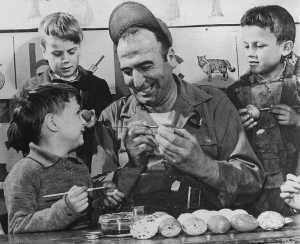
Sgt. George A. Crist, 1st cook, US 8th AF/96th Bombardment Group, teaches British lads the art of Easter egg decorating.
###########################################################################################
EASTER HUMOR –
############################################################################################
Farewell Salutes –
Abelardo Alinaya – Born:Cavite, P.I./Oxnard, CA; US Navy (ret. 20 years), Vietnam, Bronze Star, Silver Star
Thomas Anderson – Matamata, NZ; LAC Air Force # 3021698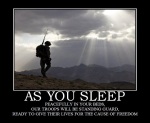
John Fuller Jr. – Wasilla, AK; USMC, WWII, PTO, Silver Star
Kerry Hunter Jr. – Pekin, IL; US Navy, Desert Shield, Desert Storm
Stanley Lloyd – Long Beach, NY; US Navy, Lt-JG, WWII
George Mosher – Port Huron, MI; US Army, WWII, ETO, 94th Infantry, Purple Heart
Robert Richard – Fitchburg, MA; US Army, Korea
W. LaVerne Strader – Willis, TX; US Army Air Corps WAC, WWII, [w/ 4 sisters & 4 brothers – all military WWII]
Russell Tucker – Saraland, AL; US Army (Ret.), Captain, WWII/US Air Force, Korea, pilot
David Watkins – Colorado Spring, CO; US Army, Vietnam
###########################################################################################
Personal note – I received my Easter present yesterday, my book, “Three Came Home” by Agnes Keith, looking forward to that after I finish “For Crew and Country” by John Wukovits, which I only just started.
Also – A HAPPY SHOUT OUT to all the Arkansas veterans!
###########################################################################################
Okinawa, August 1945
19 August 1945, Japanese Lt. General Kanabe and fifteen other emissaries secretly left Kazarazu air base in two Mitsubishi “Betty” bombers, painted white with green crosses, as ordered by General MacArthur, to comply with the surrender of the Philippines at Manila. After landing at Nichols Field and met by General Sutherland, they surrendered their swords. During the initial meeting, the Japanese were instructed to have 400 trucks and 100 sedans at Atsugi Airfield in readiness to receive the 11th Airborne. This caused much concern with the dignitaries. Atsugi had been a training base for kamikaze pilots and many of them were refusing to surrender. There were also 300,000 well-trained troops on the Kanto Plain of Tokyo, so MacArthur moved the landing for the 11th A/B to the 28th of August; five days later than originally planned.
There was much discussion as to whether or not the 11th Airborne would fly into Japan or parachute down. Troopers tried jumping from the B-24s on the island, but it proved to be an awkward plane for that purpose. To carry the men to Japan and then return was impossible for the C-46, therefore C-54s were brought in from around the world and crammed onto the island.
GHQ ordered General Swing to form an honor guard company for General MacArthur. Captain Glen Carter of the 187th regiment became the company commander. Every man was required to be 5′ 11″ or taller.
18-20 August, the Soviet army overran the Kwantung Army in central Manchuria, taking three cities in three days. They continued south in the quickest campaign of Soviet history, killing 80,000 Japanese.
28 August was to be the intended date for U.S. arrival in Japan, but two typhoons put a snafu on the trooper’s strategies. My father recalled, during their prolonged stay on the island, meeting some of the 509th Bomber Group. They were feeling guilt or remorse or still in shock over the extent of damage and death that had been created by the two atomic bombs. What they had witnessed through their goggles seemed to be a nightmare straight out of “Buck Rogers. The airmen begged, borrowed, but usually purchased an 11th A/B patch to sew over their own before entering Japan. Smitty said he gave away so many of them because he could not imagine the panorama of destruction they had seen or the gut feelings they would carry for the remainder of their lives. They were men who carried out their orders, but they were hurting.
The Emperor was wary of any fanatical emotions that might still be lingering within the kamikaze pilots. Therefore, he sent his brother, Prince Takamatsu, with a team to dismantle the propellers from their planes to prevent any “heroics” from occurring before MacArthur’s plane, the Bataan, was scheduled to land. The previously all-powerful Japanese Army had had such control over the country for so long that these precautions had to be fulfilled to ensure a peaceful occupation. This was all carried out while the Emperor still believed he would be executed as a war criminal.
CLICK ONTO PHOTOS TO ENLARGE
###########################################################################################
Resources: Angels: History of the 11th Airborne Division and Rakassans by E.M. Flanagan, Presidio Press; Pacific: Day by Day by John Davison, Chartwell Books; Everett’s scrapbook; The Pacific War by John Costello,pub. RawsonWade
###########################################################################################
“This is an Alert”
Saturday, 11 August 1945, top secret orders were delivered to General Swing for the division to be prepared to move to Okinawa at any time. The division G-3, Colonel Quandt, called Colonel Pearson, “This is an Alert. Have your regiment [187th] ready to move out by air forty-eight hours from now.” Commanders throughout the 11th A/B had their men reassembled, even those on weekend passes had been found and brought back to camp. The lead elements left Luzon immediately. At 0630 hours on the 13th, trucks brought the 187th to Nichols and Nielson Fields for transport and they landed at 1645 hours that afternoon at Naha, Kadena and Yotan Fields on Okinawa. They would remain on the island for two weeks.
It would take the 54th Troop Carrier Wing two days to transport the 11th Airborne using 351 C-46s, 151 C-47s and 99 B-24s; with their bombs removed and crammed with troopers. The planes had carted 11,100 men; 1,161,000 pounds of equipment and 120 special-purpose jeeps for communication and supply. Eighty-six men remained on Luzon long enough to bring the 187ths organizational equipment to Okinawa by ship.
Okinawa, as one of the islands being “beefed-up” with supplies, men and materiel, quickly became significantly congested; it is only 877 square miles. One day would be unbearably hot and the next would bring the heavy rains that created small rivers running passed their pup tents. The troopers were back to cooking their 10-in-1, ‘C’ or ‘K’ rations on squad cookers or eaten cold. A typhoon crossed the island and the men were forced to live on the sides of hills with their pup tents ballooning like parachutes and taking off in the wind. In the hills were numerous old Okinawan tombs that the Japanese troops had adapted into pillboxes and these helped to protect the men from the storms.
I believe it was about this time that Smitty discovered that there was an opening on General Swing’s staff. My father requested the position and happily received it. Swing was not certain how the enemy would take to him and the 187th regiment landing in Japan, so the men were ordered to be combat ready. Besides staying in shape, they spent many an hour listing to numerous lectures on the Japanese culture. The 187th regiment of the 11th Airborne Division would be the first troops to enter Japan, as conquerors, in 2000 years.
Also, on 13 August, two ships, the Pennsylvaniaand the La Grange were hit by kamikaze carrier planes. All ships in Okinawa harbors were shipped out to ensure their safety. Although the Emperor was at this point demanding peace, the complicated arrangement of their government (Emperor, Premier, Cabinet, Privy Seal, etc. etc.) made it difficult for them to answer the Allies immediately. As Soviet forces, hovering at the 1.5 million mark, launched across Manchuria and approximately 1600 U.S. bombers hit Tokyo.
14 August, the Emperor made a recording to be played over the Japanese radio stating that their government had surrendered to the Allied powers and to request that his people cooperate with the conquerors. The fanatics, mainly Army officers and also known as die-hards or ultras, attempted to confiscate the prepared discs and claim that the Emperor had been coerced into accepting the Potsdam Declaration. People died in this mini revolution and others committed hara-kiri when it failed. Some enemy pilots continue to fly their Zeros as American planes went over Japan.
15 August, Washington D.C. received Japan’s acceptance of the terms of surrender. Similar to the Western Electric advertisement pictured, phones and telegraphs buzzed around the world with the news that WWII was over, but reactions varied. Among the men on Okinawa, there was jubilation mixed in with ‘let’s wait and see.” In Japan, most felt relieved, but others committed suicide to fulfill their duty. Russian troops continued to push into Manchuria to get as far into the area as possible before the Allies could stop them. Troops in Europe were elated to hear that they were no longer being transferred to the Pacific. South America began to see the arrival of Nazi escapees and the United States went wild with gratitude.
___________________________________________________________________________________________
Resources: “The Rising Sun” by John Toland; “Rakkassans” and “Angels: History of the 11th Airborne Division” by E.M. Flanagan; “Pacific: Day by Day” by John Davison; The 54th Troop Carrier Wing
___________________________________________________________________________________________
What would become known as: The Bomb
In a 1958 interview, Truman was asked about the soul-searching decision he went through to decide on dropping the bomb. He replied, “Hell no, I made it like _ (snapped his fingers) _ that!” One year later at Columbia University, he said, “The atom bomb was no great decision.” He likened it to a larger gun.
The components for the 20-kiloton weapon were being shipped to Tinian Island, in the Marianas, aboard the “Indianapolis.” The top-secret package arrived at its destination a mere 24 hours after the official operational order for the bomb was sent to General Carl (“Tooey”) Spaatz.
Prince Konoye, after laboring two years for a route to peace, swallowed poison and died the day before he was to turn himself in as a war criminal.
Sadly, four days later, the ‘Indianapolis’ was hit by three torpedoes and sunk within twelve minutes. The ship was without a sufficient number of lifeboats, her disappearance went unnoticed for almost four days and the navy search team was called off early. Therefore, only 316 men of her 1,196-man crew were rescued. This has been considered the most controversial sea disaster in American history.
The bomb, when it arrived, was a metal cylinder approximately 18 inches in diameter and two feet high, but when fully assembled, it measured ten feet long and 28 inches in diameter. It had originally been nicknamed “Thin Man” after the movie and the expected shape, but when it was completed, they changed it to “Little Boy” and gave the small bundle its own hiding place. The secrecy involving the bomb storage area was so secure that a general was required to have a pass to enter.
The other members of the 509th Bomber Group, not included in the mission, knew something was brewing, but they also were unaware of the exact plans. Hence, an anonymous writer was inspired:
Into the air the secret rose,
Where they’re going, nobody knows.
Tomorrow they’ll return again,
But we’ll never know where they’ve been.
Don’t ask about results or such,
Unless you want to get in Dutch.
But take it from one who is sure of the score,
The 509th is winning the war.
The crew of the ‘Enola Gay’ even received a humorous menu as they entered the mess hall for breakfast:
Look! Real eggs (How do you want them?)
Rolled oats (Why?)
Milk (No fishing)
Sausage (We think it’s pork)
Apple butter (Looks like axle grease)
Butter (Yep, it’s out again)
Coffee (Saniflush)
Bread (Someone get a toaster)
After takeoff, they met up with their two escort planes, ‘The Great Artiste,’ which carried scientific equipment and Number 91 (never named) carrying photographic gear.
6 August 1945, “Enola Gay,” dropped the first atomic bomb, the equivalent of 20,000 tons of TNT, on the city of Hiroshima, killing 180,000 people. The B-29 bomber was piloted by Colonel Paul Tibbets, Jr. and First Lieutenant Morris Jeppson. The crew was required to wear special goggles after the bomb was released to avoid blindness. Due to the lack of information, the crew of the Enola Gay did not expect to return from their bombing mission. The Manhattan Project (two cities built to develop the weapon) originally cost two billion dollars (The equivalent today would be approximately 27 billion.)
All clocks in Hiroshima stopped precisely at 8:15 am.
Hiroshima University surprisingly stood intact after the explosion presumably due to its completely white veneer, but for some unknown reason its clock had eerily stopped at 8:15 — the previous day.
The Emperor, throughout his life, had been described as looking like a small town mayor, completely unselfish, without vanity or ambition. He had always wished to be a marine biologist rather than a monarch. As Emperor, once the military leaders and the cabinet made a decision, he could not withhold his support. He had never wanted war, but had complied. (To explain the complex layout of the Japanese government at that time would require much more room than we have here.) Once the atomic bombs were dropped, the Emperor threw tradition to the wind and emphatically insisted upon peace. This would cause a civil war of sorts with the government.
8-9 August, at midnight, the Soviets declared war on Japan and Manchuria. This was contrary to their original agreement to wait until the 15th of the month. It became obvious to all that Stalin was now making his agenda quite clear as to his wish for the “spoils of war.” Truman, who had wanted the Soviets in the war, now realized that they would be a hindrance.
9 August, ‘Bock’s Car’ dropped the next atomic bomb, “Fat Man,” which was nicknamed after Churchill or Sidney Greenstreet’s character in “The Maltese Falcon,” there are two conflicting stories. The bomb killed 80,000 people. This second bomb was different in that it was a spherical plutonium missile, ten feet long and five feet in diameter. The plane made three unsuccessful runs over the city of Kokura, but due to the lack of visibility, they went on to Nagasaki. Jake Beser, an electronics specialist, was the only crew member
to make both atomic bomb runs.
___________________________________________________________________________________________
Always sad to see another veteran pass on …
____________________________________________________________________________________________
Resources: Pacific War On-line Encyclopedia; “The Rising Sun” by John Toland; “The Last Great Victory’ by Stanley Weintraub; “VFW Pictorial History of WWII”; AOL Images; Palm Beach Post.
_____________________________________________________________________________________________
Remeber to click on a photo to view more clearly.
Truman and the Potsdam Conference
“Operation Iceberg,” the invasion of Okinawa began on 1 April 1945 and would basically end 22 June. Many are unaware that small skirmishes continued even after the 11th Airborne Division landed on that island. But … as we enter into July, others matters begin to develop.
Harry S. Truman did not have the outstanding record that most people look for in a president. He had poor eyesight and was unable to complete a 4-year college. Later, he failed as the owner/operator of a small mining and oil business, as a farmer and then as a haberdasher. (In my opinion, that only left politics as an option.) HST was elected to the Senate with the assistance of the corrupt Thomas J. Pendergast and proved to be an unimportant legislator. His only military achievement was in successfully tightening up the discipline of the rag-tag outfit he was given. He was chosen as the Vice-Presidential candidate because southern democrats liked him and FDR needed those votes. (I’m afraid these facts were located during research, they are not my own thoughts – unless specified.)
This was the man sent to Germany, sailing on the “Augusta” with Secretary of State, James Byrnes and Admiral Leahy to attend the Potsdam Conference to begin on 17 July 1945. The primary agenda for the massive meeting dealt with the revision of the German-Soviet-Polish borders and the expulsion of several million Germans from the disputed territories. The code name for this conference was “Terminal,” with Stalin, Churchill and Truman representing the three major powers.
16 July was significant in that the Atomic bomb was successfully tested, exploding the equivalent of 20,000 tons of TNT and a blast point of 750 degrees F. Oppenheimer would then prepare the test results for his report to Henry Stimson in Potsdam. Truman confided the news to Churchill and the two rulers instantly decided that at least two bobs would be dropped on Japan. This decision was made despite the arguments of Adm.Leahy, General “Hap” Arnold and Gen. Dwight Eisenhower who strongly spoke against it’s use, calling it completely unnecessary. Many of the scientists that worked on the Manhattan Project felt that such a dramatic scientific discovery should not be used. The petition, “…the liberated forces of nature for the purpose of destruction … open the door to an era of devastation …,” was signed by 57 scientists. They had the foresight to visualize the nuclear problems that we face today, but their qualms went unheeded.
The Potsdam Proclamation demanded the unconditional surrender of Japan, but did not make mention of two clearly important issues – (1) that the atomic bomb was is existence and (2) whether or not the Emperor would retain his seat in the palace. Both of these provisions would have clarified the true situation for the Japanese Army. Many, on-site at Potsdam, believe that the Japanese were purposely and maliciously misguided.
26 July, the same day that Clement Attlee defeated Winston Churchill in the election for Prime Minister, the Potsdam Declaration was sent to the enemy. The exact wording of this document made it unthinkable for Japan to accept. Once again, the lack of understanding for a foreign culture would hinder the road to peace.
Keep in mind, while still at sea on the ‘Augusta,’ Byrnes had received a message from Sweden stating that Japanese Major Gen. Makoto Onodera, having authorization from the Emperor, wished to enter into peace negotiations. The only stipulation being that the Emperor remain in power.
By this time, Prince Konoye had spent two years laboring to uncover a route to peace. The prince had had the correct procedure all along, but mistakenly had chosen the Soviet Union as the go-between. Stalin had his own agenda in mind for the Japanese and their territories and therefore he deceitfully strung the envoys along with various delaying tactics. OSS Allen Dulles, who assisted in negotiations when Italy fell, was working on the same premise in Switzerland. Nevertheless, as spring turned to summer, militarists in Japan continued to plan for Operation Decision (Ketsu-Go) and ignored their government’s attempts for peace. Disregarding Japan’s concern for their Emperor, the Potsdam Declaration was considered by Premier Suzuki and the military to be a re-hashing of the Cairo Declaration which deemed it to be marked as “mokusatsu” (‘ignore entirely’ or ‘regard as unworthy of notice’)
In regards to the A-bomb, Secretary of War, Stimson and his assistant, John McCloy, told Truman, “We should all have our heads examined if we don’t try to find a political solution.” Truman laughed.
_______________________________________________________________________________________________
So many manuevers, conversations and secrets go on behind the main headlines, but here is one story I hope you take the time to click and read. This obituary was in “The Week” news-magazine and I could not resist including it here. Could any of us do this job today?
_______________________________________________________________________________________________
Resources: U.S. Department of State, Office of the Historian; “The Week” magazine; “The Last Great Victory” by Stanley Weintraub; University of Virginia, Miller Center.
_______________________________________________________________________________________________
Note of interest – 17 July 1945, kamikaze units were no longer voluntary.
_______________________________________________________________________________________________
Missed photos – YTD
As the 11th Airborne Division plans to move on to Okinawa, I am posting additional photos that I previously omitted to avoid clutter and distract from the stories. I hope you enjoy them.
Smitty wrote on the reverse side of this picture that it was the first cemetery on the island that they built. The shadowy figure on the bottom has always been a mystery. My father said no one was there when it was taken, but to me it does appear to be a man.
____________________________________________________________________________________________
____________________________________________________________________________________________
Smitty must not have always been on patrol or training recruits, the photograph on the left was addressed to Mr. Everett Smith, from Dheadora D. Bella, Imus, Cavite, P.I. and on the front it is signed – With Love, Doriny. On the right is signed – Adorable ___ Med, Paulit & Lila. (Should any descendents recognize these photos, please give me more information on who they were. Thank you)
____________________________________________________________________________________________
Below, General Pierson (right) examines the bullet holes in a Japanese glider downed near Manila with Frank Smith (left), the war correspondent from the Chicago Sun Times that traveled with the 11th Airborne.
____________________________________________________________________________________________
Remember to click on any photo you need to see more clearly. I hope you have enjoyed this blog thus far and will continue to view as the 11th Airborne Division moves on to Okinawa.
____________________________________________________________________________________________
Letter from General Joe Swing
On Christmas Eve, 1944 General Joseph M. Swing composed a letter to his father-in-law, General Peyton C. March to sum up the actions of the 11th Airborne Division on Leyte. Random House has granted me permission to reprint this letter originally published in “THE ANGELS: A History of the 11th Airborne Division,” by E.M. Flanagan Jr. (received from Mrs. Mary Anne Fullilove, nee Swing) and published by Presidio Press. I thank you.
Dear General,
Am just back from a few days in the mountains, as a matter of fact I’ve walked clean across this d____ island and it wasn’t the most pleasant jaunt I ever took. Wish you could see these young men of mine fight. It would do your heart good to see the calm joyful manner in which they kill the rats. I really believe this is the first time the Japs have run against American troops that never stop coming. It has been the custom in this so called jungle warfare for troops to start “holing up” an hour or more before sundown and form their so-called perimeter from which they never venture forth until after cooking individual breakfast at daylight – taking an hour to do so. As a result, the Japs bivouac at their ease, have scouts watch the formation of the perimeter and then heckle our troops all night. We changed that – made my troops keep going until dark, then dig in so the Japs don’t know where we are located and finally got them to the point where they would start out just before the crack of dawn without breakfast. As a result, we’ve killed about twice as many Japs in proportion to our own casualties as had any other division. The last day, the 22d, when we busted out of the hills to where the 7th Division was sitting on the beach – the dawn attack caught 300 Japs sleeping outside their foxholes and we slaughtered them there with bayonet, knife and hand grenades. From then on it was a field day – had four battalions in column. As fast as one showed the least sign of tiring, sent the next one thru and by noon, we had done 4,000 yards – took a break for breakfast and at 1430, we were on the beach and the 7th Division bivouac. Counted approximately 750 dead Japs and didn’t go down the cliffs where many of them rolled off – captured two mountain howitzers, 1000 rounds of ammunition, 16 light machine guns, seven heavies, and the Japs left engineer, signal and medical supplies and many split-toed shoes along the trail. Have told the Corps commander if he wants to walk from Burauen air fields to Ormoc beach all he has to do is put a clothes pin on his nose and let a man with a strong stomach guide him.
Our identification shows that we cleaned out the 16th and 26th Division completely. The two had consolidated in the Mt. Mahonag region and initiated the attack on the airfields in conjunction with the paratrooper attack of Dec. 6th. Have killed the Chief of Staff of the 16th Division and most of the staff of both divisions but unable to locate the two commanding generals. Prisoners of war say they were replaced by new commanders but believe they were evacuated by air. Of course the devils bury their officers and booby trap their bodies so we’ll never know.
Am taking a week to evacuate to the beach and reequip for an airborne operation, but as I told you some time ago the staff is a pain in the neck to me so far as having little imagination. Afraid they can’t supply us once we’re in and we have practically supplied ourselves with cub planes for over a month in the mountains. Come under Eichelberger’s command on the 26th. He has already sent word he wants to see me about an airborne operation, so maybe we’ll have a chance to do our stuff. You probably surmised the orthodox manner in which they will attack Luzon. Have a spot picked out south of Manila that would give the so and so’s fits if I can convince the powers to land me there. Xmas greetings,
Sincerely,
Joe
________________________________________________________________________________________________
General Peyton C. March (12/27/1864 – 4/13/1955) is known to World War I enthusiasts as the commander of the United States First Army. Also, then as Army Chief of Staff, he created additional branches, one being the U.S. Army Air Corps.
_________________________________________________________________________________________________
gpcox – When Making a Car Was Illegal
Judy was kind enough to invite me back for my fourth guest post. She did a wonderful job of displaying what information I gave her and added some of her own. I hope you will all enjoy the article and take a moment to tell us what you think of it or even add your own thoughts on the subject. Thank you for coming.
"Greatest Generation" Life Lessons
This is the latest Guest Post from gpcox all about the vehicles in service during World War II and a little about what the American Family had to sacrifice back home.
When Making a Car Was Illegal
After Pearl Harbor, President Roosevelt ordered all car manufacturers to cease the production of private automobiles and convert the factories to produce military
vehicles, weaponry, airplane engines, parts, etc. But, this would not put an end to man’s love affair with the automobile. A car manual became priceless to a private owner and a truck manual was an absolute necessity for a farmer or businessman. With the rationing of gasoline in the U.S., the “National Victory Speed” was 35 mph and driving clubs were encouraged. (Our modern day car-pools).
Automobiles were produced in massive quantities before the Great Depression and this brought the price down considerably. Then, the stock market crashed and many…
View original post 853 more words
“Operation Downfall”
The original idea for the invasion of Japan was approved in July 1944 and received constant, precise detailing up until the actual signing of the surrender. Operation Downfall was broken into two separate plans, Operation Olympic which would be followed by Operation Coronet.
With all the devastation already incurred on Japan, a forceful occupation would still be very costly. The Japanese Army controlled the government and their wish was a fight down to the last man, woman and child. Later on, members of that army stated that it would have been an all out suicide effort of every person in Japan to fight to the death.
Operation Olympic, which included 750,000 troops were to land on Southern Kyushi 1 November 1945. In the first wave, Army, Navy and Marine personnel – 436,486; the second wave to hold 356,902. (How they managed to be so specific is way over my head.) The air support would total 22,160. The D-Day Operation Overlord would have paled in comparison and this led the Joint Chiefs of Staff to agree that this rendered Russia’s involvement unnecessary.
MacArthur’s estimations of casualties and wounded that he sent to Washington were judged by the invasion of Luzon. Gen. “Vinegar Joe” Stilwell sent his report based on the Okinawa battles; these were much higher.
While Europe’s “Overlord” had beach codes such as: Omaha, Utah, Sword and Gold, “Olympic” had a variety of automobiles for the beaches that were then grouped by type. Gen. Krueger’s Sixth Army, that included the 11th Airborne Division, was scheduled to land at Miyazaki, the eastern prefecture of Kyushu, the third largest island of Japan. The forty-mile long shallow beach areas were coded as ‘Chevrolet’, ‘Chrysler’ and ‘Cord.’ (Highlighted sections on map above.) At the time, there were approximately 126,000 Japanese troops in that zone. Even after both atomic bombs were dropped, the Sixth Army was expected to have 15,000 casualties.
MacArthur had wanted to keep Gen. Eichelberger close to him and direct the operations since his record with the 11th A/B on Luzon was so efficient. As had been mentioned previously, the five-star general felt that Gen. Krueger had led a rather undistinguished campaign thus far.
The itemized tons of materiel listed in the plans grew beyond comprehension. P-51 Mustang fighters were shipped to Guam still in their crates. Stocking grew on Tinian, Saipan, Samar, Luzon, Hawaii, the Marianas, the Carolines and the west coast of the U.S. (just to name a few). The logistics could only be explained by experts.
In a memo from the Undersecretary of the Navy, a project named “Dagwood” was mentioned, but I am unable to locate any details. MacArthur sent out a deceptive message (with slip-shot secrecy) to be intercepted by the Japanese called “Pastel Two.” This showed a detailed “plan” about Allied landings on the China coast. The Panama Canal had a steady stream of ships loaded with men, equipment and supplies. Seven more atomic bombs were on order for “Olympic” British, Canadian and Australian divisions were to be re-equipped with American weapons and logistical support to standardize the entire operation. The Allied planners felt they would ultimately involve 5 million men. (Operation Overlord in Europe totaled 150,000 men and 1,500 tanks.) They expected opposition from 5,000 kamikazes, which proved later to be correct. The main objective for “Olympic” would be to secure Kagoshima Wan; a great landlocked bay for which men and supplies would flow through for the post-invasion buildup.
(Click on photos to enlarge.)
Operation Coronet would follow Olympic on 1 March 1946 and would be a more massive invasion. The main objective then would be Tokyo Bay on Honshu.
The Naval plans were also far too complex for me to completely list here, but to give you an idea – Halsey’s Third Fleet was assigned eastern Honshu and the Fifth Fleet would take western Honshu, Kyushu and Shikoku. The Seventh Fleet would be at Korea (south of the 38th parallel) and Admiral Fletcher’s North Pacific Force would cover Hokkaido.
_______________________________________________________________________________________________
After the fall of Saipan, Japan knew they were forced to strengthen their homeland defenses. Yet this progress was moving slowly; labor was scarce, with the lack of fuel their mobilization was slow, production, food and weapons were decreasing rapidly. The country was becoming very tired of war. Covering the Japanese islands were four ground armies of eight divisions and 14 cadre divisions; plus three air defense divisions. Immense manpower groups were expected to bring this to 56 divisions, 38 brigades, somewhere in the vicinity of 2 million new men. War materiel was to be brought in from Manchuria. The Japanese plan of defense was called “Ketsu-Go.”
I realize the map is difficult to view even after you click on it, but try to see the black squares which represent Japanese defenses with artillery.
_______________________________________________________________________________________________
The 11th Airborne, training the reinforcements and handling the “mopping-up” details on Luzon were beginning to set odds on whether or not the war would end before “Olympic” went into play. The combined “Operation Downfall” was a “go” up until the ink on the surrender papers dried.
_______________________________________________________________________________________________
For Paul Putnam for his father Robert, a veteran of the 11th Airborne
Resources: ‘The Last Great Victory’ by Stanley Weintraub; History Learning Site; U.S. Army Heritage; ‘The Angels’ by Gen. E.M. Flanagan; ibiblio.org
_______________________________________________________________________________________________
_______________________________________________________________________________________________
Guest post #4 at Greatest Generations will be posted next Tuesday, please stop in and read about the vehicles, civilian and military during the WWII era. Let Judy and I know what think or even add some more info for us. Thank you.
Jump on Aparri
With his thoughts still focused on his R&R in Australia, Everett “Smitty” Smith landed back at Lipa City, P.I. only to discover that a mission was scheduled. The last remaining organized Japanese group, the Shabu Forces, were hold up in the northeast corner of Luzon and General Swing had organized the Gypsy Task Force to take them out. On his orders, this unique unit would include “all Camp MacKall veterans.” This would include men from the 187th Infantry, the 511th, the 457th Parachute Field Artillery Battalion, a platoon from the 127th Engineers and two platoons from B Company. Despite Gen. Krueger’s disapproval, Lt. Col. Henry Burgess, now 26 years old, would be the commanding officer. (Smitty was at the ancient age of 30, one of the oldest paratroopers besides one other soldier and a few of the officers.) Col. Lahti (31) would be CO for the reserve unit.
Col. John Lackey, CO of the 317th Troop Carrier Group, with very little notice, began loading 54 C-47s and 13 C-46s at 0430 hours, 23 June 1945. His plane was the first to leave Lipa airstrip and the constant rumbling of the planes soon became “Vs” in the open skies. Within the transports, every man appeared as a clone to the next. Individuality was lost among the uniforms, bundled parachutes and rucksacks filled to capacity with ammunition, first-aid, water and C-rations.
Each man stood and checked the chute of the man beside him when the “Gooney Birds” lurched at 0900 hours; the smoke flares from the forward Pathfinders were spotted and green lights flashed for the paratroopers. The stick of men hooked up to the static lines and proceeded to jump into vertical development. With mandatory, disciplined silence, the traditional battle cry, “Geronimo,” is only heard within the imaginative faculty of 1,030 men. All these diverse personalities would react separately to the same experience.
Each man, for his own reasons, volunteered for the perilous duty that might end his life. Each man went through various stages of development and arrived at the same destination. Each man had been chosen for their good health, general toughness and honor. A jump into combat is reality in its most crystalline form.
As the ground races up to meet the troopers, they see the tall, thick fields of the sharp kunai grass, flooded rice paddies, carabao ruts and bomb craters – all would prove dangerous. The Task Force would lose 7%, two men killed and 70 wounded as they landed in 25 mph winds. The battle-hardened paratroopers collected their flame throwers, howitzers and rifles from the gliders and reassembled with “Espirit de Corps.”
The 11th Airborne battled the Shabu Forces on a 75 mile hike in 120 degree heat to connect up with the Connolly Task Force. The combined goal was to prevent the enemy from escaping into the Cagayan Valley and out to sea. Lt. Col. Burgess met Gen. Beightler, on 26 June, and received a rather snide remark about how his men had saved the 11th A/B. Burgess became quite red-faced and replied that he was under orders to save the 37th Division. Gen. Swift, standing off to one side, laughed and said, “Well, you SOUND like one of Swing’s boys.”
The Gypsy Task Force marched away to the 37th’s Headquarters to request C-47s to transport the unit back to Lipa. Burgess was denied and told to countermarch to Aparri and have the trucks take them south to Manila. That would mean they would still need to march another 55 miles from Manila to Lipa. Instead, the men bribed the C-47 pilots with Japanese swords, guns and various other paraphernalia in exchange for a flight back. (Necessity is the mother of invention.)
Bold headlines exploded in the Australian newspapers: U.S. Paratroopers Land In Northern Luzon – “After the 11th A/B Division made their air-borne landing near Aparri on June 23rd., using their gliders for the first time, carrying howitzers, jeeps and mobile equipment. Each trooper jumped with 100 pounds of gear strapped to his body.”
In the 26 June 1945 issue of The Army News – “On Saturday, from 600 feet into paddy fields, the 11th Airborne dropped near the port of Aparri in a surprise move against the Japanese forces in northern Luzon. They used their gliders for the first time in the southwest Pacific…”
3 July, General Swing made an offical note stating that he had implored the higher echelon of the Sixth Army two months previous with a plan to drop the entire 11th Airborne Division onto northern Luzon back when Gen. Krueger’s men were having so much trouble with the Japanese in Balete Pass. He expressed his frustration that his own plan to attack Aparri had gone unheeded. The Japanese had been given the opportunity to withdraw just enough to unite with reinforcements.
_______________________________________________________________________________________________
Resources:
Angels: History of the 11th Airborne Division, Rakkasans (both books by Gen. E.M. Flanagan) and The Pacific War (John Davison),Trove Australian archives. photos : AOL images
Sorry to be reposting this, but it has NOT shown up in the Reader under my Tags. So, I’m trying it again. Thank you for your patience.
